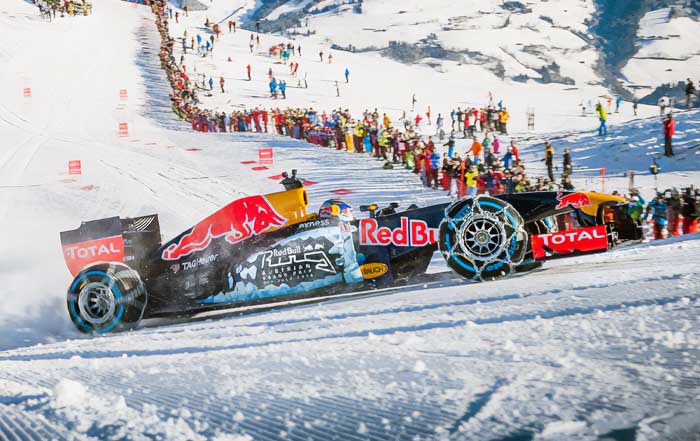Few sporting events capture the imagination of the global audience quite like Formula 1. The FIA Formula One World Championship has grown from its modest beginnings in the 1950s into a multi-billion-dollar industry that combines speed, engineering mastery, strategic brilliance, and a spectacle that transcends borders. In 2025, Formula 1 is not merely a racing series—it is an ecosystem that influences technological innovation, global branding, travel destinations, and cultural exchange.
This article explores the thrill of Formula 1 Grand Prix through the lenses of speed, design, technology, and its broader influence beyond the racetrack. It examines how the sport has evolved into a cultural and economic powerhouse, while maintaining its heritage of pushing human and mechanical limits.
The Global Spectacle of Speed
At its core, Formula 1 is a celebration of speed. Cars regularly exceed 220 miles per hour, testing the reflexes and courage of drivers who must balance risk and control within fractions of a second. Races take place in diverse locations—from Silverstone in the United Kingdom to Monza in Italy, and from the glittering streets of Monaco to the night lights of Singapore. This global footprint makes F1 not just a sporting contest but also a tourism magnet and a stage for national pride.
The drama of speed is amplified by the unpredictability of conditions. A sudden rain shower at Spa-Francorchamps in Belgium or a gust of desert wind in Bahrain can redefine strategies instantly. Fans, whether in grandstands or watching broadcasts via Sky Sports or ESPN, witness more than just racing; they experience the ultimate test of man and machine, where milliseconds separate glory from defeat.
For readers passionate about sports, xdzee.com/sports.html provides deeper insights into global sporting events that share the same pulse-raising excitement.
Engineering Marvels and Aerodynamic Design
The true magic of Formula 1 lies beneath the carbon-fiber skin of its cars. Every vehicle on the grid is a masterpiece of engineering, shaped by thousands of hours of wind tunnel testing, computational fluid dynamics (CFD), and precision manufacturing. Aerodynamics dictate performance, with the iconic wings, diffusers, and underbody channels designed to balance downforce and drag.
Teams like Mercedes-AMG Petronas, Red Bull Racing, and Ferrari lead the way in design innovation. For instance, the ground-effect regulations reintroduced in 2022 reshaped how cars interact with the track surface, allowing for closer racing and fewer aerodynamic disturbances. By 2025, advances in computational modeling have refined these concepts, pushing cars to levels of efficiency once thought impossible.
Such progress in motorsport frequently transfers to consumer vehicles. McLaren Automotive and Aston Martin use lessons from F1 to enhance the aerodynamics and safety of their road cars, proving the sport’s influence on the wider automobile industry.
Travelers inspired by design and adventure can explore related stories at xdzee.com/adventure.html, where engineering meets exploration.
Cutting-Edge Technology Driving Performance
Formula 1’s technological ecosystem is one of the most advanced in the world. The hybrid power units, introduced in 2014, revolutionized the sport by integrating internal combustion engines (ICE) with energy recovery systems (ERS). These units not only reduced environmental impact but also demonstrated the efficiency of hybrid technologies on a global stage.
Now sustainability and electrification are central themes. Formula 1 is committed to achieving net zero carbon emissions by 2030, aligning with global climate initiatives and demonstrating motorsport’s role in driving eco-conscious innovation. The shift toward synthetic fuels, developed in collaboration with companies like ExxonMobil and Aramco, exemplifies how the sport balances sustainability with its tradition of speed.
Beyond engines, advanced materials science has reshaped performance. Lightweight composites, heat-resistant alloys, and advanced braking systems ensure both speed and safety. The use of AI-driven telemetry enables teams to process millions of data points during a race, allowing engineers to fine-tune strategies in real time.
Readers interested in performance innovation can explore xdzee.com/performance.html for broader insights into cutting-edge sports and technology.
Formula 1 Dashboard 2025
Global Motorsport Excellence
Global Racing Calendar
Drivers as Global Icons
Formula 1 is not only about machines; it is equally about the men and women who dare to tame them. Drivers are at the center of the spectacle, and their talent, charisma, and resilience transform them into global icons. Lewis Hamilton, with his record-equalling seven world championships, transcends the sport through activism on diversity and sustainability. Max Verstappen, the relentless Dutch driver for Red Bull Racing, has captivated a new generation of fans with his aggressive driving style and dominance in the early 2020s. Rising stars like Lando Norris and Charles Leclerc embody the future of the grid, blending youthful exuberance with remarkable technical skill.
Drivers also serve as brand ambassadors for luxury fashion houses, tech giants, and lifestyle products. Collaborations between Lewis Hamilton and Tommy Hilfiger, or Daniel Ricciardo with Puma, illustrate how F1 personalities extend their influence into culture and commerce. Their presence on platforms like Instagram, TikTok, and YouTube amplifies reach, making Formula 1 more accessible to younger demographics.
For those curious about how sports figures evolve into cultural leaders, xdzee.com/culture.html offers perspectives on the intersection of fame, leadership, and society.
Strategy and Teamwork Behind the Scenes
Although Formula 1 is often portrayed as an individual sport, victory is built on collective brilliance. Each race weekend requires the coordination of hundreds of specialists—from aerodynamicists to mechanics and race strategists. Pit stops lasting under two seconds epitomize precision teamwork, where a fraction of hesitation could cost positions.
The role of strategy has grown exponentially in the hybrid era. Decisions on tire compounds, fuel management, and energy deployment often decide outcomes more than outright pace. Advanced simulations run by teams during races assess thousands of potential scenarios, giving drivers the information they need to succeed under pressure.
Team principals like Christian Horner of Red Bull, Toto Wolff of Mercedes, and Fred Vasseur of Ferrari have become personalities in their own right. Their leadership and decision-making illustrate the corporate dimension of Formula 1, where managing multimillion-dollar budgets, sponsorships, and talent pipelines are as critical as engineering excellence.
For deeper reflections on teamwork and leadership within competitive industries, readers can explore xdzee.com/business.html, where lessons from sport often mirror corporate realities.
Economics of Formula 1
Formula 1 has grown into a financial giant. Each season generates billions of dollars through sponsorships, broadcasting rights, race hosting fees, and merchandise. Major sponsors such as Rolex, Petronas, Oracle, and Santander leverage Formula 1’s global reach to connect with diverse audiences. The presence of luxury brands like Tag Heuer and Richard Mille reinforces the association between F1 and prestige.
Host cities pay enormous sums—often exceeding $50 million annually—to stage a Grand Prix, confident that the returns in tourism, global exposure, and infrastructure investment justify the expense. The Singapore Grand Prix alone has been credited with generating hundreds of millions of dollars for the local economy, while the recent additions of races in Miami, Las Vegas, and Saudi Arabia highlight how Formula 1 strategically taps into emerging markets.
Employment opportunities linked to F1 are equally significant, spanning engineers, logistics specialists, hospitality staff, and event managers. The sport serves as a fertile training ground for careers in engineering, business, and marketing.
For job seekers and professionals exploring careers tied to global sports, xdzee.com/jobs.html provides resources and insights.
Tourism and Destinations
The Formula 1 calendar doubles as a global travel itinerary, drawing fans to iconic destinations. Each Grand Prix offers more than just racing; it showcases the culture, cuisine, and landscapes of the host country. The Monaco Grand Prix, with its yachts and luxury hotels, remains the epitome of glamour, while the Japanese Grand Prix in Suzuka reflects Japan’s meticulous attention to hospitality and tradition.
In recent years, destination branding has become central to F1. Nations like Azerbaijan and Qatar use races to enhance international visibility, blending sport with diplomacy. Meanwhile, historic venues like Monza and Silverstone preserve the heritage of motorsport while adapting to modern demands.
For readers seeking travel inspiration beyond motorsport, xdzee.com/travel.html and xdzee.com/destination.html highlight global journeys that, much like Formula 1, blend excitement, culture, and adventure.
Media, Branding, and Global Reach
Formula 1’s transformation into a mainstream global spectacle owes much to media evolution. The introduction of Formula 1: Drive to Survive on Netflix revolutionized fan engagement, offering behind-the-scenes access and humanizing the sport for millions who had never watched a race before. This docuseries ignited surges of interest in the United States and beyond, contributing to record-breaking attendance figures and television ratings.
Social media campaigns amplify this effect. Teams operate like media companies, producing daily content to engage fans. Platforms like YouTube, Twitter (X), and TikTok extend the drama beyond Sundays, ensuring a year-round conversation.
Global branding opportunities are immense. Cities hosting Grand Prix events gain exposure to millions of viewers, positioning themselves as dynamic centers for tourism and investment. Brands that associate with Formula 1 harness the values of speed, precision, and innovation to strengthen their identities in competitive markets.
Stories of branding excellence are explored further at xdzee.com/brands.html, where sport intersects with global commerce.
Evolution of Safety in Formula 1
The history of Formula 1 is as much about overcoming tragedy as it is about celebrating triumph. In its early decades, the sport was notoriously dangerous, with rudimentary safety measures and limited medical facilities. Drivers like Ayrton Senna and Jim Clark paid the ultimate price, and their legacies continue to inspire improvements in the sport’s approach to safety.
By 2025, Formula 1 is a benchmark for safety innovation. The introduction of the Halo cockpit protection system in 2018 marked a turning point, shielding drivers from potentially fatal head injuries. Initially controversial for aesthetic reasons, the Halo has since saved multiple lives, proving its necessity. Advances in crash structures, stronger helmets, and fire-resistant suits ensure that modern drivers race under unparalleled levels of protection.
The FIA’s commitment extends beyond cars to circuits. Modern tracks incorporate vast run-off areas, energy-absorbing barriers, and advanced medical facilities. High-profile incidents, like Romain Grosjean’s fiery crash in Bahrain in 2020, underscore how safety systems continue to evolve.
Safety is not just technical; it has become part of the culture. Drivers, teams, and regulators prioritize well-being without compromising the competitive spirit. For readers interested in broader discussions on risk management and protective measures in sport and life, xdzee.com/safety.html provides additional insights.
Future of Formula 1
The next decade will define whether Formula 1 can maintain its position at the pinnacle of motorsport while adapting to global shifts. Sustainability is central to this mission. With the 2030 net-zero goal, the sport is investing heavily in synthetic fuels and sustainable logistics. Partnerships with global energy leaders will accelerate innovation, creating solutions that extend far beyond racing.
Electrification is a complex topic. While Formula 1 remains committed to hybrid engines rather than full electrification—leaving fully electric racing to Formula E—its focus on efficiency ensures that the technologies developed will benefit future transportation. The inclusion of AI and machine learning in race strategy, simulation, and vehicle development further signals how the sport is pushing the limits of innovation.
There is also an expansion in audience demographics. Initiatives like the F1 Academy for women drivers, launched in 2023, highlight efforts to make the grid more inclusive. With fan bases growing rapidly in regions like Asia, the Middle East, and North America, Formula 1 is poised to enter new markets while retaining its European heritage.
Readers intrigued by innovation and technology in sports and business can explore xdzee.com/innovation.html for further context.
Cultural Influence of Formula 1
Formula 1 is more than a sport; it is a cultural phenomenon. Races bring together celebrities, politicians, and business magnates, creating an atmosphere that combines entertainment and networking. Events like the Monaco Grand Prix are social calendars in themselves, attended by figures from Hollywood, fashion, and global finance.
The sport influences fashion, music, and cinema. Collaborations with brands like Louis Vuitton, Balenciaga, and Hugo Boss elevate F1 beyond racing into lifestyle. In film, franchises such as Rush and documentaries like Senna highlight the human drama behind the spectacle, reinforcing its cultural footprint.
In nations like Italy, Formula 1 is part of national identity, with Ferrari embodying pride and passion. In newer markets like the United States, races in Las Vegas and Miami blend motorsport with entertainment festivals, ensuring appeal to broader audiences.
For deeper explorations of cultural intersections, readers may visit xdzee.com/world.html and xdzee.com/lifestyle.html, where global culture and lifestyle trends are showcased.
Formula 1 as an Adventure
Formula 1 encapsulates the essence of adventure. The sport demands resilience and adaptability, as drivers confront diverse terrains—from the fast straights of Monza to the technical corners of Suzuka. Fans, too, embark on adventures, traveling across continents to witness races in exotic locations. The expansion of races to Qatar, Mexico, and Australia enhances the sense of global exploration.
The adventure is not only physical but emotional. Every lap delivers tension, risk, and exhilaration. Fans experience a rollercoaster of emotions as strategies unfold and rivalries ignite. The thrill of uncertainty keeps millions glued to the spectacle, season after season.
Adventure stories, whether through motorsport or outdoor pursuits, are celebrated at xdzee.com/adventure.html, where risk and reward are central to human experience.
Integration with Lifestyle and Brands
Formula 1’s influence extends seamlessly into lifestyle and branding. The sport has always carried an aura of glamour, with luxury watches, designer fashion, and high-performance cars symbolizing its identity. The presence of brands like Chanel, Rolex, and Pirelli ties the sport to exclusivity and elegance.
Hospitality packages, such as Paddock Club experiences, cater to elite audiences who seek both business networking and leisure. Meanwhile, fan engagement has democratized the lifestyle side of F1, with affordable merchandise, digital fan tokens, and interactive apps ensuring inclusivity.
Brands leverage the association with speed, precision, and cutting-edge technology to strengthen their global appeal. Whether it is Heineken promoting responsible drinking campaigns or AWS showcasing cloud computing innovations, Formula 1 acts as a global platform for message delivery.
For comprehensive insights into branding in sports and global industries, readers can turn to xdzee.com/brands.html.
Business, Ethics, and the Formula 1 Ecosystem
Behind the roar of engines and the glamour of podium celebrations lies a business ecosystem that defines Formula 1’s global impact. Each team operates as a corporate entity, blending engineering with financial management, sponsorship acquisition, and brand building. Companies like Red Bull Racing and Mercedes-AMG Petronas are not only racing teams but also marketing machines, generating billions in value through exposure and partnerships.
The governance of Formula 1 under the Fédération Internationale de l’Automobile (FIA) and Liberty Media, which owns the commercial rights, reveals the delicate balance between sport and commerce. Decisions on calendar expansion, cost caps, and sustainability goals reflect a strategic vision that considers not only competition but also ethics and social responsibility.
Formula 1 faces scrutiny on issues ranging from environmental impact to hosting races in nations with controversial human rights records. The debate over whether sport should remain politically neutral or serve as a platform for ethical leadership is ongoing. Drivers like Sebastian Vettel and Lewis Hamilton have been vocal advocates for climate action and social justice, ensuring that F1 continues to engage in ethical debates that resonate with global audiences.
For readers invested in the ethics of global industries and how sports intersect with societal issues, xdzee.com/ethics.html provides critical analysis.
Formula 1 as a Travel Economy Driver
Few sports contribute to global tourism like Formula 1. Host cities receive international exposure that boosts visitor numbers far beyond race weekends. The Abu Dhabi Grand Prix, for instance, transforms Yas Marina Circuit into a hub of concerts, festivals, and luxury experiences. Similarly, the Australian Grand Prix in Melbourne injects hundreds of millions of dollars into the local economy, benefiting hotels, restaurants, and airlines.
Travelers attending F1 events often extend their stays to explore local culture and landmarks, making the sport a gateway to broader tourism. This phenomenon is particularly pronounced in destinations like Singapore, where night races coincide with cultural festivals, or Mexico City, where the race is integrated into vibrant national celebrations.
For those seeking to understand how global sports stimulate travel industries, xdzee.com/travel.html and xdzee.com/destination.html offer further exploration.
Formula 1 in the World of News and Media
The speed of Formula 1 extends into the global news cycle. Headlines surrounding driver rivalries, technical upgrades, or controversies about track conditions dominate international sports media. Outlets like BBC Sport, Sky Sports, and ESPN ensure that F1 remains a fixture of weekend coverage, while digital platforms provide live updates, in-depth analytics, and exclusive interviews.
The sport also thrives on its unpredictability, with controversies such as the 2021 Abu Dhabi finale or ongoing debates about budget caps fueling endless media discussions. The combination of high drama and real-time global coverage ensures that Formula 1 transcends traditional sports journalism, becoming a broader conversation about fairness, innovation, and spectacle.
For curated perspectives on breaking stories, xdzee.com/news.html delivers analysis across sports, business, and world affairs.
Formula 1 as Global Inspiration
Ultimately, Formula 1’s influence goes far beyond circuits and cars. The sport inspires future generations of engineers, scientists, and athletes. Children attending races often dream of becoming the next Hamilton or Verstappen, while students studying aerodynamics or mechanical engineering see F1 as the pinnacle of applied science. Universities and corporations collaborate with teams on research projects, ensuring that the knowledge generated by racing fuels innovation in multiple industries.
Formula 1 also serves as a metaphor for modern life: resilience in the face of adversity, adaptability under changing conditions, and the relentless pursuit of excellence. The discipline required to succeed at the highest level mirrors the challenges faced by businesses and individuals striving for growth in competitive global markets.
Adventure-seekers, entrepreneurs, and dreamers alike find lessons in F1’s journey—from its dangerous beginnings to its technologically advanced present—that resonate across cultures and industries. For those drawn to the intersection of performance, lifestyle, and world events, xdzee.com offers a hub of stories that capture the same energy and ambition.
Conclusion
Formula 1 is not just about cars speeding around a track; it is a global phenomenon that embodies speed, design, technology, culture, and ethics. From its cutting-edge engineering to its role in shaping global tourism, branding, and sustainability, the sport has evolved into a cultural and economic force that reflects the aspirations and challenges of our era.
In 2025, Formula 1 stands at the crossroads of tradition and transformation. It honors the legacy of legends while embracing sustainability, inclusivity, and innovation. For fans, it remains the ultimate expression of speed and adventure. For industries, it is a laboratory of technology and branding. And for the world, it is a spectacle that continues to unite millions across continents, languages, and cultures.
The thrill of the Grand Prix is eternal—an enduring testament to humanity’s pursuit of excellence, adventure, and the relentless drive to go faster, further, and beyond.








